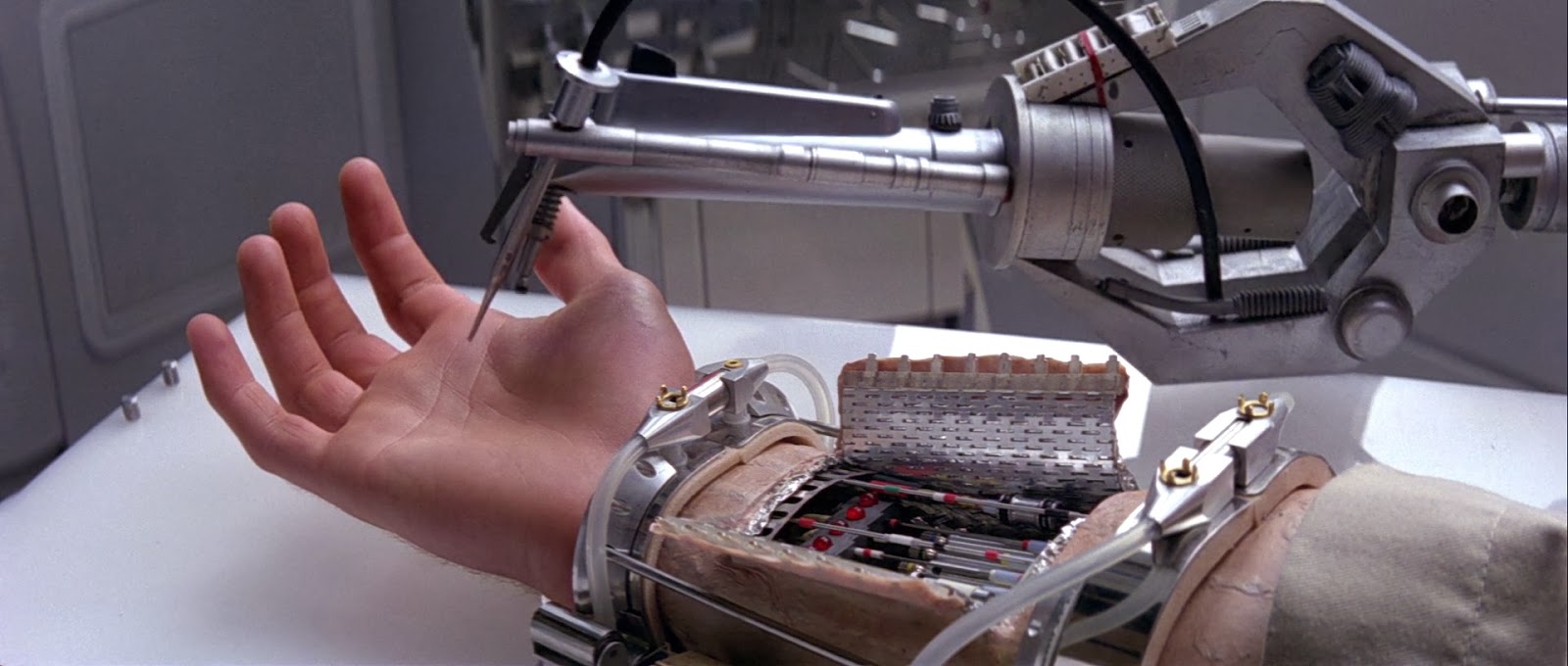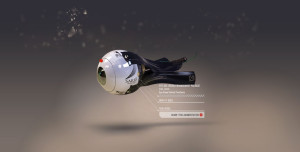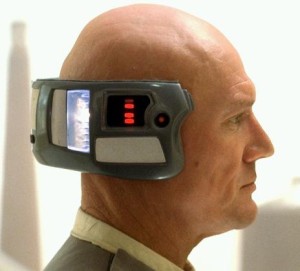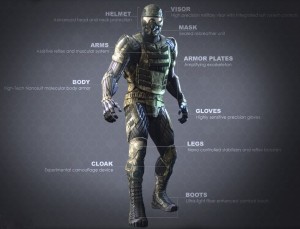
In our first article in this series, we discussed the possibilities of what might occur should organics and their most trusted and relied upon synthetics come into conflict. Today, we’re going to turn the tables around and reverse that premise: what happens when we fuse man and machine to an even greater degree than ever before? One of the most integral elements of Darth Vader’s character is that he is a cyborg: a sinister and inhuman blend of flesh and metal that serves as the physical representation of his inner corruption by the dark side (not everyone can have glowing yellow eyes like the Emperor, after all).
When Luke Skywalker loses a hand, his is replaced by a pleasantly fleshy quintet of fingers that is, to our knowledge, identical in appearance and function to its predecessor. There’s clearly a galaxy of difference between their prostheses, but how often do we actually think about that contrast, and what it means for the universe?
Luke’s prosthetic hand is easily one of the single most desirable pieces of technology in the entire franchise, at least from our perspective. Think about it: a perfect replacement to any dismembered member, without any loss in feeling or function, visually indistinguishable from the real thing, and requiring little in the way of adjustment or rehabilitation. Not to mention the fact that it’s clearly no extraordinary item – the notoriously underfunded and outgunned rebellion was able to prepare and attach one only a handful of scenes after he lost the original.

Surprisingly few characters throughout the Expanded Universe seem to have taken advantage of the available technology, however, at least that we’re aware of. If someone has lost any important parts in the past, it’s usually clear from a glance – their mechanical limbs are bare of synthetic skin, exposed to the world, and their replacement eyes turned into glowing lenses rather than something less conspicuous, like an actual eye.
Darth Vader and General Grievous are obviously the most high profile examples of cybernetic augmentation in saga – perhaps not coincidentally, both were also forcibly transformed into cyborgs by others in order to preserve their lives and their usefulness to their new masters. Grievous’ case is the more extreme of the two, with even fewer of his original organs surviving than those of the half-melted lump of meat once known as Anakin Skywalker, but also stands as a testament to the incredibly advanced level of medical treatment in Star Wars.
They can keep beings alive that would have undoubtedly perished had they suffered those same injuries on our own Earth, and in Grievous’ case, take things one step further and grant them enhanced physical abilities far beyond what any normal flesh-and-blood organic is capable of. In a more minor (but no less meaningful) example, Lando’s aide on Cloud City, the aptly-named Lobot, was sentenced to have a cybernetic implant connected to his brain (vastly increasing his mental acuity in the process) and to serve as a living interface to the floating city’s computers in lieu of more traditional punishments for his crimes.

For the most part, however, such attachments serve as little more than flavor, a bit of spice to add to what might otherwise be a bland and forgettable character design. Rarely is it demonstrated or even considered that an individual’s replacement limbs might serve other (potentially more dangerous) functions than what is immediately apparent. In one recent notable example, the video game Deus Ex: Human Revolution contains what is undoubtedly one of the most thorough explorations of the concept to date, with a vast array of “augmentations” ranging from cybernetic arms allowing you to break down walls with nothing more than your bare (metal) hands to legs that are strong enough to leap over them to optical implants that permit you to see straight through them.
The societal changes brought on by the invention and widespread adoption of revolutionary human modification is a central part of the game’s background, and while the situations are far from similar (in that cybernetics as old a technology in Star Wars as just about anything else), the general premise does raise a number of interesting questions if we start to think about the different attitudes that might exist regarding such technology.
Despite the level of sophistication that is clearly available, many seem to refrain from taking advantage of more realistic-looking prostheses, preferring to instead sport skinless metal limbs and glowing red eyepieces. Is this a matter of cost and convenience, or one of personal preference? Do some leave them exposed deliberately, as a reminder of the loss of their original appendages? Are there many who choose to forgo prosthetic limbs entirely, as the Jedi Tenel Ka and Wolf Sazen did? If there is a some undefined amount of anti-droid prejudice in the galaxy, does that extend to include visibly heavily modified cyborgs?

Do there exist those who choose to voluntarily undergo extensive augmentation in order to gain an edge, physical or mental, over their wholly organic rivals and enemies? The Iskalloni (inspired by Star Trek’s Borg) collectively embraced this approach as a species – does their fearsome reputation taint other cyborgs by association? As with Lobot, are there worlds where cyborg servitude (voluntary or involuntary) is a common punishment? If there are, how might their practices come into conflict with the laws of the Republic and the philosophy of the Jedi?
While we’re on the topic of replacing flesh with metal and blood with oil, it’s also worth taking the time to discuss the possibility of mechanical enhancements of somewhat less radical and permanent natures. Despite the necessary technology clearly being available (at least as things stood in the old Expanded Universe), there exist remarkably few examples of what might be referred to as “powered exoskeletons” in the franchise.
Recently made famous on the big screen by the Marvel superhero Iron Man (and his allies, and enemies), such exoskeletons have been an iconic part of the science fiction genre for years, particularly in video games where they often provide a simple and straightforward justification for having a wide variety of (usually entirely human) enemies and bosses with access to unusual offensive and defensive abilities that the player does not have.
The concept is hardly foreign to Star Wars: the Dark Forces and Jedi Knight games frequently made use of it with everything from Hazard troopers to Shadowtroopers, and the likes of Rom Mohc and Galak Fyyar donned their own personal suits of armor (shielded, even, in the latter’s case) when the time came to do battle with Kyle Katarn.
Unfortunately, this has very rarely carried over into more mainstream works. With even just a few pieces of a suit of armor, otherwise ordinary characters might have a chance at equaling a Jedi or Sith in ways that normally only Mandalorians do. Protected by a full set with all the bells and whistles that entails, the odds might even be in their favor.

Mass-produced, an army of soldiers clad in powered exoskeletons could easily overrun their more traditionally equipped counterparts and pose a significantly greater threat than their numbers might otherwise indicate. The technology is there – armor that can resist lightsaber blades, personal deflector shields able to turn away blaster bolts and explosions, jet packs, blasters and repulsors built into hands, personal stealth fields – all that remains is for some enterprising warlord or crime boss to invest the time and money necessary to acquire it and put it to good use.
Considering how ludicrously outclassed they normally are against all but the most inexperienced of lightsaber wielders, it’s actually surprising that more don’t attempt to forge themselves something to balance the odds, or at least procure the services of someone with the skills and tools to do it for them.
In our own world, the development of increasingly advanced prostheses and powered exoskeletons are among the most interesting and rapidly growing of emerging technologies, and I think we can do considerably better than merely harvesting from them as an occasional source of replacements for lopped-off limbs and quick power boosts for video game bosses. The fact that we can remove entire appendages with great frequency and then proceed as if nothing ever happened does not necessarily mean that that is what we should do.
Regardless of the ease with which we might replace a lost limb, the fact that it was severed in the first place should not be an injury so easily glossed over. Furthermore, the use of these technologies can give otherwise normal characters advantages normally only obtainable by those with access to mystical binding energy fields – something that ought not to be ignored, given the common complaint of how useless everyone who isn’t a Jedi frequently seems to be.
And, perhaps most importantly, if we’re to seriously examine the question of the sentience of droids, then we can hardly ignore the matter of what it truly means to be human – or alien – in a universe where the machines can appear as lifelike as any living being and the living beings are replacing parts of themselves with machines that are indistinguishable from the real thing.
